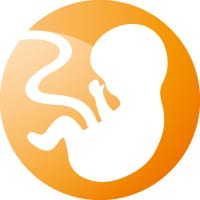Discover the Gold Standard
B·R·A·H·M·S is the provider of a complete prenatal screening biomarker portfolio Learn morePrenatal Screening (PNS)
 The goal of prenatal screening is an early risk assessment for diseases or conditions in a fetus before it is born as well as estimation of the maternal risk to develop pregnancy-related disorders. Serum biomarkers play an essential role in identifying pregnancies that are at risk for fetal aneuploidies such as Trisomy 21 (Down syndrome), Trisomy 18 (Edwards syndrome) and Trisomy 13 (Patau syndrome), fetal Neural Tube defects and maternal pre-eclampsia.
The goal of prenatal screening is an early risk assessment for diseases or conditions in a fetus before it is born as well as estimation of the maternal risk to develop pregnancy-related disorders. Serum biomarkers play an essential role in identifying pregnancies that are at risk for fetal aneuploidies such as Trisomy 21 (Down syndrome), Trisomy 18 (Edwards syndrome) and Trisomy 13 (Patau syndrome), fetal Neural Tube defects and maternal pre-eclampsia.
B·R·A·H·M·S KRYPTOR GOLD and B·R·A·H·M·S KRYPTOR prenatal screening assays are fulfilling the requirements established by Fetal Medicine Foundation (FMF) for the biochemical screening for chromosomal abnormalities and pre-eclampsia.
Download Fetal Medicine Foundation Certificate >
Aneuploidy screening
Trisomy 21 or Down syndrome is the most common aneuploidy and affects about 1 in 700 births worldwide. In a combined screening approach in the first trimester (weeks 8-14 of gestation) more than 90% of fetal trisomy 21 cases and 95% of pregnancies affected by trisomies 18 and 13 can be identified by a combination of serum biomarkers Free β hCG (human chorionic gonadotropin) and PAPP-A (pregnancy-associated plasma protein A), ultrasound measures and maternal history. Ref-1 The performance of the combined first-trimester trisomy screening can further be improved by including measurements of serum PlGF (placental growth factor) and AFP (alpha fetoprotein). Ref-2
Trisomy screening can also be performed in the early second trimester of pregnancy (weeks 14-19 of gestation) by combining the biomarkers AFP, Free β hCG or hCG+β, uE3 (unconjugated estriol) and inhibin A (quad test) with maternal characteristics. This will result in a detection rate of about 70% at a false positive rate of 5%. Ref-3 In addition, the AFP value measured in weeks 15-20 of gestation will indicate a risk for neural tube defects, which needs to be confirmed via an ultrasound examination.
Women being at high risk for fetal aneuploidies are recommended by gynecologist to undergo an invasive diagnostic test such as amniocentesis or CVS (chorionic villus sampling) to confirm the result of the screening.
Pre-eclampsia screening
Pre-eclampsia – also known as pregnancy poisoning – is a pregnancy related disorder that affects 2-8% of all pregnancies. First clinical signs such as hypertension and proteinuria can be observed after week 20 of gestation. Ref-4
With the help of the serum biomarkers PAPP-A and PlGF combined with biophysical markers such as MAP (mean arterial pressure) and UAPI (uterine artery pulsatility index) and maternal history, the risk for developing pre-eclampsia later in pregnancy can be assessed already during the first trimester in weeks 11-14 of gestation, resulting in a detection rate of 75-90% at a false positive rate of 10%. Ref-5 Women at high risk of developing pre-eclampsia should be monitored closely and low-dose aspirin can be prescribed for a possible prevention of the disease.
For women who show signs and symptoms of pre-eclampsia after week 20 of gestation it is beneficial to measure the biomarkers PlGF and sFlt-1 in addition to other clinical and medical assessments to better identify women who will have pregnancy complications.
Watch expert opinion videos
Start screening for pre-eclampsia now!
PD Dr. Cahit Birdir, University Hospital Dresden, Germany
Pre-eclampsia is a serious pregnancy related disorder
Prof. Emmanuel Bujold, Department of Obstetrics & Gynaecology, Laval University's School of Medicine, Canada
Prof. Fabricio Costa, Department of Obstetrics & Gynaecology, Gold Coast University Hospital, Australia
Risk calculation
Besides the biochemical and biophysical measurements prenatal screening software with dedicated algorithms is essential to guarantee a reliable risk calculation. Fast Screen pre I plus is a modern, powerful and robust prenatal screening software for first and second trimester risk calculation for trisomies and first trimester risk calculation for pre-eclampsia. Fast Screen incorporates high quality trisomy and pre-eclampsia algorithms and includes medians calculated based on 220 000 healthy pregnancies to provide a reliable and effective risk calculation.
Quality
A responsible risk assessment requires high precision and accuracy in the measurement of the biomarkers. All prenatal screening KRYPTOR assays fulfill the strict quality requirements of the Fetal Medicine Foundation (FMF) and are considered the gold standard in prenatal screening since 1999.
Automated assays on KRYPTOR for prenatal screening:
- B·R·A·H·M·S AFP KRYPTOR
- B·R·A·H·M·S Free βhCG KRYPTOR
- B·R·A·H·M·S hCG + β KRYPTOR
- B·R·A·H·M·S PAPP-A KRYPTOR
- B·R·A·H·M·S PlGF plus KRYPTOR
- B·R·A·H·M·S sFlt-1 KRYPTOR
- B·R·A·H·M·S uE3 KRYPTOR
- B·R·A·H·M·S Inhibin A KRYPTOR
- Risk calculation Software B·R·A·H·M·S Fast Screen pre I plus
All assays as well as Fast Screen software are CE marked.
Further links on prenatal screening
References aneuploidy screening and pre-eclampsia screening
Ref-1: Kagan KO et al. Hum Reprod 2008; 23: 1968-1975.
Ref-2: Kagan KO et al. Ultrasound Obstet Gynecol 2012; 40(5): 530-5.
Ref-3: Nicolaides KH (2011), Prenat Diagn, 31(1): 7-15.
Ref-4: L. Ghulmiyyah and B. Sibai, “Maternal Mortality From Preeclampsia/Eclampsia” Semin. Perinatol., vol. 36, no. 1, pp. 56–59, 2012.
Ref-5: N. O’Gorman et al., “Competing risks model in screening for preeclampsia by maternal factors and biomarkers at 11-13 weeks gestation.” Am. J. Obstet. Gynecol., vol. 214, no. 1, p. 103.e1-103.e12, Jan. 2016.
